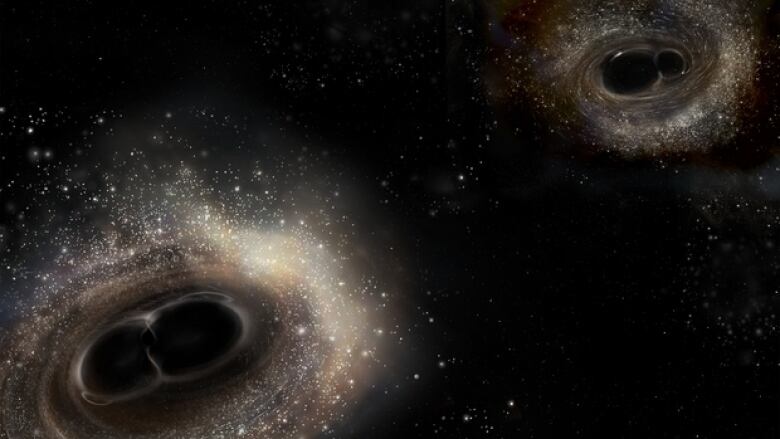3rd gravitational wave detected, opening 'new window on the universe'
Detection helps astronomers better understand formation of black holes

A third gravitational wave has been detected by the Laser Interferometer Gravitational-wave Observatory (LIGO) after the merging of two black holes in a galaxy three billion light-years away, scientists say.
The colossal merger was detected on Jan. 4, just over a month into LIGO's observing run.
The first detection of such an event was headline newsin September 2015. Worldwide, scientists were thrilled to discover an event theorized by Albert Einstein 100 years ago in his general theory of relativity. A second one was detected in June 2016.
Black holes are some of the most massive objects in our known universe, which pull in anything that gets too close, including light. When two merge, they produce an incrediblysubtle signature the gravitational wave which warps space-time.
These ripples in space-time can only be detected by powerful instruments. LIGO, operated by Caltech and MIT with hundreds of people working around the world, includes two detectors one in Hanford, Wash., and the other in Livingston, La. that are capable of measuring a rippleby as little as 1/1,000th of a proton.
In terms of mass, this newly created black hole sits right between the first two detected, at 49 times that of our sun. The first one was 62 solar masses, the second 21.This is also the furthest gravitational wave detected, with the others roughly 1.4 billion light years away.
"So far all the binary black holes observed all have differentmasses," said HaraldPfeiffer, a scientist at theCanadian Institute for Theoretical Astrophysics at the University of Toronto who is part of the LIGO team.
"This indicates that there's quite a variety in the type of black holes that emit gravitational waves that are colliding with each other."
Spin and tilt
The new data also helps astronomers determine how binary black holes are created. As a pair of black holes spiral around one another, they also rotate, in the same manner planets or moons do. Sometimes they spin in the same direction in which they are moving, other times in the opposite direction. They can also be tilted.
While the detection doesn't tell scientists if these doomed black holes were tilted or not, it does suggest that one of them may have been spinning in the same direction.
We're learning where we're coming from. And that's the big excitement.- LauraCadonati, LIGOScientific Collaboration
Astronomers are particularly interested in determining how binary black holes are created. One theory suggests that they are formed separately and then come together, which could have spins in any direction.
Another is that they form from already paired stars that collapse into black holes. If they are formed in this manner, it's believed that the spins would be in the same direction. Because only one has been found that may have been spinning in a different direction suggests that the pair wereformed separately.
Einstein right again
As well, it supports another of Einstein's theories, which discusses something called dispersion. This happens when light waves in a physical medium travelat different speeds, depending on their wavelength. Einstein said that this could not happen in gravitational waves as they make their way towards Earth. The scientists could not find any evidence of this dispersion.
LIGOwill begin its next observing run in late 2018. Before then, the detectors' sensitivity will be further improved.
The research team is excited about this new discovery and what it means for better understanding our universe.
"Before our discoveries, we didn't even know for sure that these black holes existed," said Laura Cadonati,deputy spokesperson for the LIGOScientific Collaboration, in a teleconference on Wednesday.
"What we do know now, first of all, isthat theyexist, they may have played an important role in the older universe, and we're starting to get a glimpseinto how they behave how they could have possibly formed .
"So we've opened a new window on the universe and we're learning more. We're learning where we're coming from. And that's the big excitement."












_(720p).jpg)


 OFFICIAL HD MUSIC VIDEO.jpg)
.jpg)



























































































